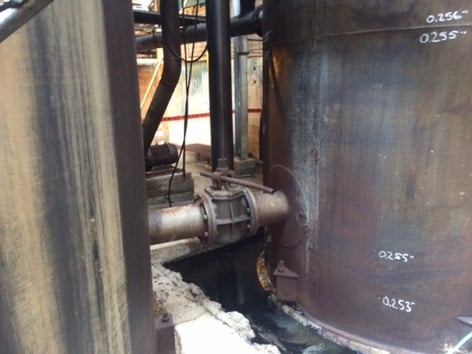The Importance of Expert Tank Welding Inspection Providers

Understanding the Relevance of Rigorous Storage Tank Welding Inspection Processes in Preventing Failures and Enhancing Life Expectancy
In the realm of industrial procedures, the value of rigorous container welding examination processes can not be overstated. By implementing numerous evaluation techniques, organizations can find problems early, thereby preventing costly effects and extending the life of their storage space tanks.
Importance of Welding Inspections
Acknowledging the essential role of welding assessments in keeping architectural honesty, these procedures ensure that welds satisfy well established requirements and specifications - Tank Welding Inspection. Reliable welding inspections are extremely important in the building and construction and upkeep of storage tanks, as they directly influence the longevity and safety and security of the frameworks. By recognizing possible shortages, such as inappropriate strategies or material defects, evaluations reduce the threat of tragic failures
Welding evaluations encompass various methods, consisting of visual assessments, non-destructive screening (NDT), and analyses of welding treatments. Each method serves to verify the high quality and conformity of welds with market regulations, consequently safeguarding both workers and ecological passions. Regular examinations foster a culture of liability and quality within the labor force, guaranteeing that all team participants stick to finest practices.
In addition, these evaluations contribute to the overall lifecycle management of storage tanks by determining wear or deterioration early while doing so. By attending to these issues proactively, companies can expand the operational lifespan of their possessions, ultimately leading to set you back financial savings and boosted dependability. In recap, the relevance of welding evaluations can not be overemphasized; they are necessary for ensuring safety and security, longevity, and conformity in container construction and maintenance.
Typical Sources Of Container Failures
Recognizing the usual causes of tank failings is necessary for stopping disastrous events and making certain the longevity of storage space systems. One common root cause of container failure is deterioration, which can substantially deteriorate the architectural honesty of containers in time. Environmental aspects, such as exposure to moisture, chemicals, and temperature variations, can accelerate this process.
An additional critical variable is incorrect welding techniques, which may result in issues like splits or incomplete joints. These problems can jeopardize the container's stamina and cause leaks or ruptures. Additionally, poor maintenance methods can result in undiscovered wear and tear, inevitably boosting the threat of failure.
Design flaws, consisting of inadequate density or bad product selection, can also add to tank vulnerabilities. Moreover, functional variables, such as overfilling or exposure to extreme stress, can stress the container beyond its intended limitations.
Key Inspection Methods
Effective inspection strategies play a crucial function in alleviating the dangers connected with tank failures. A comprehensive strategy to storage tank welding inspection entails a number of key strategies, each developed to determine prospective problems and make certain architectural stability.
Visual assessment stays the first line of protection, allowing inspectors to determine surface area anomalies such as fractures, rust, or misalignment. This method is frequently supplemented by non-destructive testing (NDT) approaches, which are essential for examining weld quality without endangering the storage tank's honesty.

Furthermore, magnetic bit screening (MPT) and color penetrant screening (DPT) are effective for identifying surface flaws in ferromagnetic materials and non-porous surfaces, specifically. Each strategy has its toughness and restrictions; for that reason, a combination of techniques is often utilized to accomplish thorough assessment outcomes.
Benefits of Strenuous Examinations
While the instant prices of rigorous assessments might appear complicated, the lasting advantages significantly surpass these initial investments. Carrying out thorough assessment refines not only improves the integrity and safety of container structures however likewise decreases the threat of tragic failings that can cause considerable economic losses and environmental injury.
Rigorous inspections help determine prospective issues early in the welding process, permitting timely corrective actions that protect against pricey repair work or substitutes down the line. This positive method promotes a society of quality control, where adherence to best techniques becomes ingrained in operational procedures. In addition, regular examinations contribute to increased asset longevity, as they make certain that containers stay in optimum condition throughout their life-span.
Furthermore, the documentation created from these examinations functions as a useful resource for upkeep planning and efficiency analyses. This data-driven technique can also enhance functional performance, causing decreased downtime and boosted productivity. Eventually, strenuous assessments not just secure the architectural honesty of tanks but likewise offer substantial financial benefits, enhancing the concept that purchasing quality control is a sensible decision for any kind of company entailed in tank operations.
Regulative Specifications and Conformity
Regulatory requirements and compliance are crucial elements of tank welding evaluation processes, as they establish the structure for making certain security and top quality in operations. Compliance with these criteria not only alleviates risks but additionally enhances the total integrity of welded frameworks. site web Different organizations, including the American Culture of Mechanical Designers (ASME) and the American Petroleum Institute (API), offer guidelines that dictate acceptable webpage practices for welding, inspection, and screening.
These criteria mandate using qualified employees, the application of extensive assessment methods, and adherence to details welding procedures. By straightening with regulative needs, organizations can guarantee that their storage tanks meet the necessary safety and security and performance criteria, therefore decreasing the probability of disastrous failures that can bring about considerable financial losses and environmental damages.

In addition, regulative conformity promotes a culture of responsibility and continual renovation within the welding and manufacture sectors (Tank Welding Inspection). Regular audits and examinations ensure that techniques continue to be lined up with developing standards, therefore promoting long-lasting integrity and operational effectiveness. Eventually, adherence to regulative requirements not only safeguards assets however likewise boosts the life expectancy of welded containers, guaranteeing they offer their intended my website function effectively gradually
Final Thought
In verdict, rigorous container welding assessment procedures play a crucial function in stopping failings and extending the lifespan of storage structures. By determining prospective shortages through various inspection methods, organizations can alleviate dangers linked with container honesty.